Perhaps travel cannot prevent bigotry, but by demonstrating that all peoples cry, laugh, eat, worry, and die, it can introduce the idea that if we try and understand each other, we may even become friends.Maya Angelou....
A collection of thoughts and tips for travel. Sharing personal experiences and those of others.
Sunday, 30 November 2014
Perhaps travel cannot...
Labels:
Maya Angelou,
quote,
travel
Saturday, 29 November 2014
Holiday gift ideas for the traveller
It's that time of year...the holiday season.
You are looking for a gift for cousin Terese, the global traveller. What to get her? Here are a few travel-related ideas to help. They are available from retailers, suppliers, and online (Amazon link is given.).
Luggage Scales - In this day of paying for just about anything when you fly, there's nothing worse than having to pay more for overweight bags. Who wants to repack at the airport check-in? A luggage scales is a great way to limit this problem.
Passport Holder - You have your passport, your other travel documents. There's your ticket. A passport holder is a great way to keep all these items together and more.
Backpack - A good backpack is essential to your trip. If you are lucky you can pack all your things in it. For those day trips they are great to pack things you need as you explore.
Amazon.com
Guidebooks - Guidebooks are a great resource. Read up on your next destination, or figure out where you want to travel next.
Amazon.com
Kindle - The Kindle reader is a great way to keep up on your personal reading. Use it when waiting for your flight, during your flight or at your destination.
Amazon.com
Smartphone camera lens kit - Smartphone cameras are great for taking photos. Sometimes they just don't capture a photo the way you want. iPhone lens attachments let you do this.
Amazon.com
Baggage tags - As you stand at the baggage claim have you ever noticed how all baggage looks the same as yours? wait for at a baggage claim? Help identify your bags visually, and also ensure that they have appropriate personal identification.
You are looking for a gift for cousin Terese, the global traveller. What to get her? Here are a few travel-related ideas to help. They are available from retailers, suppliers, and online (Amazon link is given.).
Luggage Scales - In this day of paying for just about anything when you fly, there's nothing worse than having to pay more for overweight bags. Who wants to repack at the airport check-in? A luggage scales is a great way to limit this problem.
- Camry luggage scale for up to 110 lbs.
Passport Holder - You have your passport, your other travel documents. There's your ticket. A passport holder is a great way to keep all these items together and more.
- Lewis N. Clark Rfid Document Organizer
Backpack - A good backpack is essential to your trip. If you are lucky you can pack all your things in it. For those day trips they are great to pack things you need as you explore.
- Wenger Backpack by Swiss Gear with padded sleeve for laptops
Amazon.com
Guidebooks - Guidebooks are a great resource. Read up on your next destination, or figure out where you want to travel next.
- Best in Travel 2015: The Best Trends, Destinations, Journeys & Experiences for the Year Ahead (Lonely Planet's the Best in Travel) -[Kindle edition]
Amazon.com
Kindle - The Kindle reader is a great way to keep up on your personal reading. Use it when waiting for your flight, during your flight or at your destination.
- Kindle Paperwhite Touch Screen E-Reader with Light
Amazon.com
Smartphone camera lens kit - Smartphone cameras are great for taking photos. Sometimes they just don't capture a photo the way you want. iPhone lens attachments let you do this.
- Neewer 3 in 1 Camera lens kit and tripod
Amazon.com
Baggage tags - As you stand at the baggage claim have you ever noticed how all baggage looks the same as yours? wait for at a baggage claim? Help identify your bags visually, and also ensure that they have appropriate personal identification.
- Travelon Luggage Tags - Puzzles and Swirls (set of 2)
Disclaimer: The author is an Amazon Associate.
Which way?
Labels:
humour,
Llanilltud Fawr,
Llantwit Major,
photo,
sign,
travel
Friday, 28 November 2014
Where in the world? Week 2
Where in the world is this?
Enter your answer in the comment box below.
Come back next Friday, for the answer, and another destination.
Where in the world was last week's photo?
The Canadian Museum of Civilization
Gatineau, Quebec
Located in the Capital Region of Canada, and dating back to 1856, the museum houses displays of Canadian and world civilization.
The Canadian Museum of Civilization
100 Laurier Street
Gatineau, Quebec
K1A 0M8
1-800-555-5621
http://www.historymuseum.ca/
Wednesday, 26 November 2014
Happy Thanksgiving
The day before Thanksgiving. A busy day on the roads and in the skies. If you are travelling, be safe. Don't let the crowds get to you.
Enjoy the day however you celebrate...with family, friends, or just yourself. Enjoy your traditions. Make new ones.
If you partake of a Thanksgiving Day meal with all the trimmings, enjoy.
Happy Thanksgiving...
Sunday, 23 November 2014
Friday, 21 November 2014
Where in the world?
Where in the world is this?
Enter your answer in the comment box below.
Come back next Friday, for the answer, and another destination.
Labels:
photo,
Quiz,
travel,
travel tips
A few words go a long way
So you are off to France next week! Congratulations! Bon voyage!
You have your passport. Your tickets are bought. Your bags are almost packed. You are excited about your plans to see the Eiffel Tower, Notre Dame, the Chateau de la Loire and planting yourself on a Mediterranean beach.
Just one thing....now you wish you had studied French, or had worked harder to learn the language in school.
Don't panic! Here are few suggestions to help you make your way around in in another language. Not knowing another language should not be a reason to not travel. Think how limited the world would be if everyone thought this way.
First, many signs in places like airports, train stations and tourist areas are multilingual - in the local language, English, and often one other. The graphics usually are easy to understand. Arrows will point you in the correct direction.
First, many signs in places like airports, train stations and tourist areas are multilingual - in the local language, English, and often one other. The graphics usually are easy to understand. Arrows will point you in the correct direction.
True, some languages are easier to master. This is often because they have evolved from a similar language base. Some words appear, or sound similar to words we know in English, e.g. in French - une robe - a dress. French, Italian, Spanish, Portuguese and to some point English are all based on Latin. This can be helpful, though not always foolproof. e.g. la fenetre (French) > la finestra (Italian).
Take time to learn a few simple words or phrases in your destination language. "Hello". "please", and "thank you" are always good to know. Say them with a smile and you will go far. Phrases like "Where is the washroom?", and "Where is the Coliseum?" are always useful to know. While you may not understand the answer, being pointed in the direction will help.
A smart phone can be helpful in learning a language. There are apps that teach some of the simple basics of a language - vocabulary and phrases. Rosetta Stone has a convenient app that can teach the basics of many languages. Download the app, sign up, choose the language and the learning begins. This is a great way to pass time in departure lounges and en route to a destination.
Two specific apps that are quite helpful are GoogleTranslate and WordLens. With GoogleTranslate a word or phrase in a language is keyed as if texting. Care needs to be taken with spelling. The screen will show the text in the chosen language. There is also a pronunciation, and a handwriting component for this.
Word Lens is another app. A photograph is taken of the text being translated. A destination language is chosen and soon the text appears on the screen. This app works especially well with menus, documents and signage. It should be noted that apps like these are great tools for a traveller; however, to be dependent upon them for a conversation will unrealistically slow the pace. They are more appropriate for use in specific situations.
Travelling in some areas of the world the script, and the sound of a language have no relationship to English. On a personal note, when I travelled in Arab speaking countries using the words 'shokrun' - 'thank you', and 'salam' - 'hello' brought smiles to many faces. We would communicate by pointing, using gestures, even drawing pictures.
Write down the names and addresses of hotels, restaurants, attractions and other places before heading out. Showing them to a cab driver, or someone on the street is so much easier than fumbling with the pronunciation.
Not knowing a language is not a good reason to not travel. Your resourcefulness and resiliency may astound you. Come on pack your bag!
Labels:
apps,
books,
language,
travel,
travel tips
Monday, 17 November 2014
Istanbul by photo
Photos - upper left to bottom right:
1) Sweet Istanbul - baklava on Ikstiklal Caddesi; 2) Rooftop view of Golden Horn (Altin Boynuz); 3) Ceiling in Blue Mosque (Sultanahmet); 4) Tile work at Sultan's Palace (Topkapi Palace); 5) Entrance to Sultan's Palace (Topkapi Palace); 6) Blue Mosque (Sultanahmet); 7) Hagia Sophia; 8)Sultan's Summer Residence at Palace (Topkapi Palace); 9) Istanbul side street; 10) Grand Bazaar; 11) Spice Bazaar (Egyptian Bazaar); 12) The Basilica Cisterns; 13) The Sultan's Burial Ground (Tomb of Mahmut II).
Travel plans 2015?
 Sometimes the hardest part of travelling planning is deciding where to go.
Sometimes the hardest part of travelling planning is deciding where to go. With so many places to choose this can be a hard step. Take this quiz by Lonely Planet to get an idea for your travel plans in 2015....
Share your destination in the comment box.
http://www.lonelyplanet.com/best-in-travel-quiz
Labels:
Quiz,
travel,
travel plans
Tuesday, 11 November 2014
Battlefields and Beyond: Exploring the Region Where World War I Began (article by William J. McGee)
Belgium is an amazing country...small, diverse, full things to see. This article is full of information about parts of Belgium where World War I began. It's a great resource in particular for the history buff for reading or for planning a trip.
Battlefields and Beyond: Exploring the Region Where World War I Began
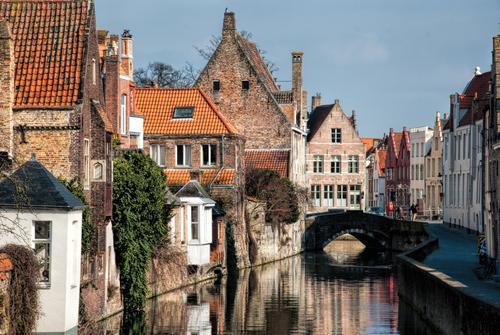
A canal in Brugge (Photo: Steven Olmstead Photography)
The stereotype that Americans are weak on history may have changed in recent years as 9/11 and its aftermath have reinforced just how small a planet we inhabit. And as record numbers of tourists flock to New York’s Ground Zero, it illustrates just how war can echo across generations.
Another war was ignited 100 years ago, though it would be years before it came to be known as World War I. At the time it was the World War, the Great War, even the War to End All Wars. And Ground Zero was the Flanders region of Belgium, where in August 1914 the Battle of Liege kickstarted what would become the largest armed conflict in history to that point. Over little more than 5,000 square miles — inside a tiny country itself the size of Maryland — more than 600,000 men, women, and children died in Flanders between 1914 and 1918.

Belgian soldiers of the 9th Mixed Brigade gather at the Battle of Liege in Belgium. (Photo: The Print Collector/Getty Images)
The rest of the world may have long moved on from World War I, but in parts of Flanders the past century has stood still. The war zone even now is referred to as “The Devastated Land,” where industrial development lagged behind the rest of Belgium clear through the late 20th Century. How devastated? Every year farmers, construction workers, and children at play still dig up artillery shells and occasionally even gas bombs. And as recently as 2011, the remains of three South African soldiers were uncovered near a brick factory.
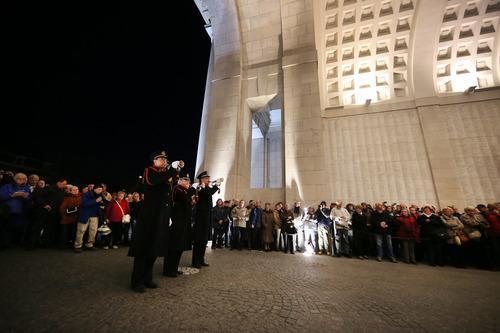
Members of the local fire brigade sound the Last Post at the Menin Gate Memorial to the Missing on March 26, 2014 in Ypres, Belgium. (Photo: Peter Macdiarmid/Getty Images)
An American can feel the years melt away at the nightly Last Post Ceremony at the Menin Gate in Ypres. Or in the rebuilt trenches. Or at any number of the seemingly endless war cemeteries dotting the countryside, which was itself reborn in the last century after ordnance leveled nearly every tree in some towns.
Both of my grandfathers served in the U.S. Army in World War I. Considering that one grandfather died before I was born and the other passed when I was quite young, I’ve never felt close to either. Yet visiting these World War I battlefields somehow forged a new connection for me. For the first time I envisioned them not as elderly patriarchs but instead as the raw and frightened — yet courageous — 20-somethings they undoubtedly were in 1918. The irony wasn’t lost on me that visiting Belgium brought me closer to two young Irish-American soldiers from New York City’s Lower East Side. That’s what travel does.
Here are some of the historic highlights of the Flanders area.
Leuven
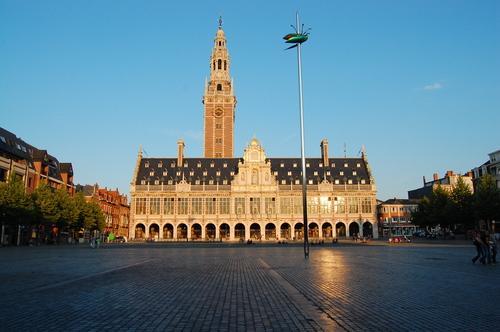
Leuven University Library (Photo: Piotr Kaźmierczak/Flickr)
This small Belgian town quickly became the focus of global attention when World War I began. Shortly after the German army occupied Leuven in August 1914, the University Library Tower was set on fire, an act of total warfare that shocked the world. (It was later set on fire again during World War II.) But an American architect and American donations helped rebuild the facility. “It’s a war memorial — and it’s very, very American,” explains Guido Claesen, a local tour guide. “It’s the most American building in our country.”
The inscribed bricks on the wall reflect the financial support lent by more than 300 U.S. institutions; the donors were comprised of many colleges, high schools, and public school systems, as well as the New York City Police Department. Even the tower’s clock reflects Belgian affection for the United States, with a design featuring 48 stars, one for each of the states in the American flag at the time.
Antwerp

Red Star Line Museum (Photo: Pieter Baert/Flickr)
Soon after the fall of Brussels in the early weeks of World War I, the Belgian capital was moved to Antwerp, where it was thought an “invincible” double ring of forts would provide protection. Within two months, German forces invaded Antwerp and the king, government officials, and much of the Belgian army retreated via a floating pontoon bridge (overall, 20 percent of all Belgians fled the country).
Related: War Tourism — a Growing Trend?
Of particular interest to Americans visiting Antwerp is the Red Star Line Museum, a fascinating dockside exhibit that chronicles the joint American-Belgian ocean passenger line that operated between 1871 and 1935. Exhibits include famous passengers (Albert Einstein immigrated to America via Red Star) and detailed stories of how Belgian-American families migrated to the United States — and how some returned to their homeland to fight in World War I.
Ghent

Castle in Ghent, Belgium (Photo: Erlend Robaye - Erroba/Moment/Getty Images)
Americans may be surprised how much of our history is intertwined with the small Belgian city of Ghent. In addition to the centennial of the start of World War I in 1914, Ghent also is commemorating the bicentennial of the 1814 Treaty of Ghent negotiations that ended the War of 1812. Although Ghent was occupied for all four years of World War I, it served as the German army’s headquarters and therefore sustained little damage.
“Our city was not destroyed,” explains Hilde Proot, a local tour guide. “They were not going to bomb a city they occupied. So our heritage was preserved.” In fact, the story of how some of that heritage was once again preserved during the Second World War was illustrated in the recent George Clooney film, “The Monuments Men.” Note: Be prepared for signage employing both spellings — Ghent and Gent.
Waregem
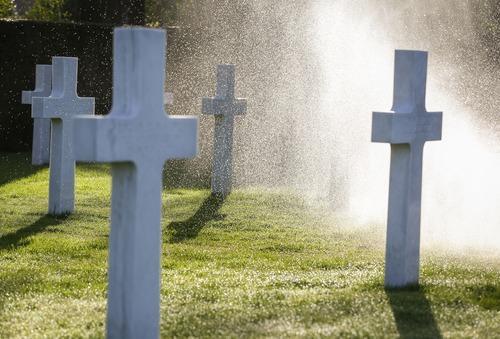
World War I Flanders Field American Cemetery in Waregem (Photo: Julien Warnand/epa/Corbis)
The American Battle Monuments Commission maintains dozens of military cemeteries worldwide, from Gaudalcanal to North Africa to Normandy. And although the Flanders region is filled with military graveyards from many countries, theFlanders Field American Cemetery in Waregem is the only U.S. facility in Belgium. Visitation has “skyrocketed” since President Obama and Belgian King Phillippe visited Waregem in March. Decoration Day (now Memorial Day) has been celebrated at Waregem since 1919; in the past, Belgian children sang “The Star-Spangled Banner” and Charles Lindbergh performed a fly-over, but the site still remains much as it did during World War I. “We want to keep this like a time capsule,” says Christopher Arseneault, the superintendent.
Ypres/Flanders Fields Region
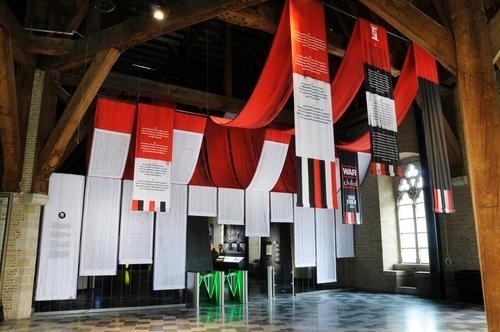
Flanders Field Museum (Photo: VISITFLANDERS/Flickr)
Ultimately, all tourists to Flanders will find themselves in the Ypres Salient battlefields and the small rural towns where some of the bloodiest fighting of World War I took place: Nieuwpoort, Polygon Woods, Passchendaele, Tyne Cot, Vladslo. The Memorial Museum Passchendele 1917 is an exercise in time travel, whereby visitors hunch down and make their way through rebuilt Allied trenches. In addition to dozens of memorials and cemeteries, every itinerary must include the In Flanders Field Museum in Ypres, a breathtakingly modern venue that makes 2014 feel like 1914.

Coquelicots in Flanders Field (Photo: Daniel Jolivet/Flickr)
Nearby is the John McCrae site, which memorializes the Canadian officer who wrote the poem “In Flanders Fields” (“In Flanders fields the poppies blow Between the crosses, row on row”). The short verse spurred the poppy’s emergence into a commemoration symbol for fallen soliders, a tradition that still exists.
World War I generated more than 16 million deaths and produced the first weapons of mass destruction in the form of deadly gases. Eventually, of course, it produced the worst conflagration in history — World War II. For many Americans, it may feel hopelessly distant.
Yet in Flanders, the First World War feels as contemporary as any of our current concerns about global conflict.
William J. McGee writes about travel and is the author of “Attention All Passengers.”
Labels:
Antwerp,
Belgium,
Brugge,
Flanders,
Ghent,
history,
In Flanders Fields,
John McCrae,
Leuven,
Remembrance Day,
travel,
Waregem,
World War I,
Ypres
Remembrance Day...overwhelming gratitude
I will never forget my experience in western Normandy many years ago. I was on a study trip in Brittany, in western France. Part of the experience included a number of excursions around the area.
This one trip in particular we went to St. Malo, from where Jacques Cartier sailed and eventually saw what is now Canada, and then on to Mont St. Michel. Mont St. Michel is the famous monastery that sits off the north coast of France and is accessible by land in low tide.
While in the area our group had dinner in a small local restaurant. While I cannot remember much about the meal years later, I will never forget the reception we received when the owner, staff and other locals found out that in the group there were several Canadians.
Their reaction was almost embarrassing. However, even though more than thirty years later, we were Canadians, and by association we represented a link to the past. The D-Day landings of World War II had been close by. In this particular area Canadians troops had been particularly active in the landing and the liberation of the area. Many of these people remembered. Others, too young to remember, knew very well the story and made the connection.
I had read accounts and seen photos of the liberation of parts of Europe at the end of the war. I could imagine the relief, the joy, the excitement and outright hysteria that was happening at the time.
For me, it became very obvious how much more than I ever anticipated the actions of Canadian troops in D-Day meant to the people of Normandy. I still wonder if we truly appreciate the efforts our Canadian troops and others made.
This one trip in particular we went to St. Malo, from where Jacques Cartier sailed and eventually saw what is now Canada, and then on to Mont St. Michel. Mont St. Michel is the famous monastery that sits off the north coast of France and is accessible by land in low tide.
While in the area our group had dinner in a small local restaurant. While I cannot remember much about the meal years later, I will never forget the reception we received when the owner, staff and other locals found out that in the group there were several Canadians.
Their reaction was almost embarrassing. However, even though more than thirty years later, we were Canadians, and by association we represented a link to the past. The D-Day landings of World War II had been close by. In this particular area Canadians troops had been particularly active in the landing and the liberation of the area. Many of these people remembered. Others, too young to remember, knew very well the story and made the connection.
I had read accounts and seen photos of the liberation of parts of Europe at the end of the war. I could imagine the relief, the joy, the excitement and outright hysteria that was happening at the time.
For me, it became very obvious how much more than I ever anticipated the actions of Canadian troops in D-Day meant to the people of Normandy. I still wonder if we truly appreciate the efforts our Canadian troops and others made.
Remembrance Day...Lest We Forget
A day of remembering events in the past. A day of remembering those who served, those who died, those who lived. A day of remembering so we learn from history's lessons.
For most of us reading this blog, the events of World War I and II, and the Korean War are 'pre-history'. They occurred in distant lands. Relating to these events is difficult. Perhaps we have relatives or family friends who fought in these conflicts and we have heard some of their stories. Of course there have been many other wars fought in our time.I have found that visiting sites that have significance in efforts to make or keep peace have had a profound effect on me.
My first time travelling into France I landed in Dunkerque. There I got to see the remains of some of the bunkers and installations used in World War II.
More recently, I have been by the Highway of Heroes as a motorcade escorting one of Canada's fallen soldiers in Afghanistan was being repatriated. This was current, happening at that moment.
These events and others made war real for me. It was not just something I read about, or in the case of Vietnam also saw on TV.
Observing this day can be done in many ways. Whatever you do...take the time to remember at 11:00 a.m. Lest we forget.
Sunday, 9 November 2014
What's your travel persona?
Not sure what your travel preferences are? Take this quiz from Aeroplan.com to find out your travel persona:
The 'Travel Bug' ...one bug that's not so bad to have...
I love to travel. I am not sure why I do, but it is a known fact...observed by
myself, my family and friends.
Perhaps it began when I was a newborn and could
not sleep at night. My parents
would bundle me up and drive around the town where we lived and eventually I would succomb to sleep.
Since then being on the road or a path, in the
air, on the rails or sea is fine with me. By the age of 5, I was reading maps and giving directions in
the car. Adults would not always
take my advice, and in more instances than not, they would find themselves lost
or having to retrace their route.
At this point I have been fortunate to travel
extensively in Canada and the U.S.
I have also had a number of experiences in the Caribbean and
Mexico. As well, I have seen a fair
bit of Europe, and some of Asia and Australia, and I am ready to return for more. I am always reading about, and hearing about, places to visit and adding them to
my list of 'must sees'. Places on that list include South America, Central America, New Zealand, Alaska and Canada's Arctic.
In this blog I hope to share many things. Some will be personal experiences. There will be tips for your travels - how to make things easier. Discussions about destinations. Sights you should see. Recommendations for a great place for coffee, or to eat? Suggested itineraries. Anecdotes and observations. I will also
include my thoughts on various topics which may help you with your trip planning and with your personal
insights.
So get ready. We are off.
Labels:
travel
Why travel?
This quote says a lot about the benefits of travel, and it's not new.
"Travel is fatal to prejudice, bigotry, and narrow-mindedness, and many of our people need it sorely on theses accounts. Broad, wholesome, charitable views of men and things cannot be acquired by vegetating in one little corner of the earth all one's lifetime.
-Mark Twain, Mark Twain: The Innocents Abroad/Roughing It
"Travel is fatal to prejudice, bigotry, and narrow-mindedness, and many of our people need it sorely on theses accounts. Broad, wholesome, charitable views of men and things cannot be acquired by vegetating in one little corner of the earth all one's lifetime.
-Mark Twain, Mark Twain: The Innocents Abroad/Roughing It
Subscribe to:
Comments (Atom)























